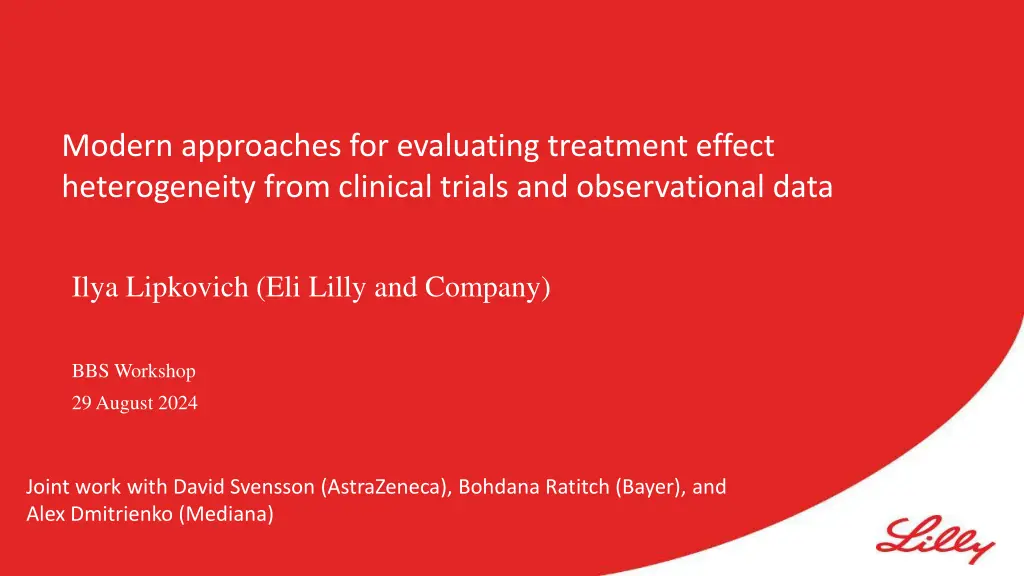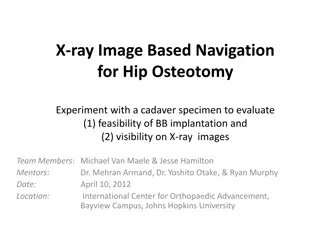
Approaches for Evaluating Treatment Effect Heterogeneity in Clinical Trials
Discover modern methodologies for evaluating treatment effect heterogeneity from clinical trials and observational data. Learn about causal frameworks, estimation approaches, subgroup identification, and more presented at the BBS Workshop. Explore how to analyze individual treatment effects, propensity scores, and conditional average treatment effects.
Download Presentation

Please find below an Image/Link to download the presentation.
The content on the website is provided AS IS for your information and personal use only. It may not be sold, licensed, or shared on other websites without obtaining consent from the author. If you encounter any issues during the download, it is possible that the publisher has removed the file from their server.
You are allowed to download the files provided on this website for personal or commercial use, subject to the condition that they are used lawfully. All files are the property of their respective owners.
The content on the website is provided AS IS for your information and personal use only. It may not be sold, licensed, or shared on other websites without obtaining consent from the author.
E N D
Presentation Transcript
Modern approaches for evaluating treatment effect heterogeneity from clinical trials and observational data Ilya Lipkovich (Eli Lilly and Company) BBS Workshop 29 August 2024 Joint work with David Svensson (AstraZeneca), Bohdana Ratitch (Bayer), and Alex Dmitrienko (Mediana)
Outline A causal framework for heterogeneous treatment effects (HTE) Four general approaches for estimating HTEs What to look at in papers on HTE evaluation? Post-selection inference on HTE Summary 2
Learning heterogeneity of TE from the data ???? ? = ? = ? ?(1) ? = ? ? ?(0) ? = ? Causal inference Post-selection inference ?- possibly high dimensional Multiple hypothesis testing Machine learning CATE: Conditional Average Treatment Effect (a.k.a ITE) 4
The set up: individual TE Each patient has two potential outcomes of ?, i.e. ??0 ,??1 corresponding to ? = 0,1; only one outcome is observed (SUTVA) Outcome function, given pre-treatment covariates ??? = ?(??? ? = ? ,? {0,1} Under treatment ignorability, ensured by randomization in RCT, or no unmeasured confounder assumption in OC ??? = ? ? ? = ?,? = ? Treatment contrast or conditional causal effect (CATE) ? = ? 1,? ? 0,? In studies with non-randomized treatments, we need to estimate propensity scores ? ? = ? ? = 1 ? = ? 5
Literature on subgroup identification is diverse S ? = {?: ? > ?} 6
Typology of Subgroup Identification; Lipkovich et al. (2017) (?) ?(?,?) ?(1,?) ?(0,?) ? ?=0 ? ? Globaloutcomemodeling: Y (?) Direct treatment effect modeling (?) ?=0 ?=0 ? ? Enhanced treatment effect for drug A Prescribe B Prescribe A Local treatment effect modeling : Subgroup search Individual treatment regimen modeling: ????{?(x)}
ITE scores vs CATE learners It is important to distinguish between estimators of CATE, ? (often presented as meta-learners, coined by K nzel et al) and an individual treatment effect (ITE) score ?estimated for a given subject in observed data ? are functions that predict ?for any subject by plugging-in their ?? Computing ITE score requires both ?? and ?? for a given subject, they are consistent estimators of ITE, ?{ ?} = ? and are used as pseudo-outcomes to model CATE Examples of ITE scores Imputed/matched counterfactuals : ? IPW score: ? 1 ? ?? AIPW score: ? Robinson s transformation: ? ???= ?? ?? ??0 + (1 ??) ??(1) ?? ???? ? ?? ??(1 ??) ????= ?1?? ?0?? +??(?? ?1??) ???= (1 ??)(?? ?0??) 1 ? ?? ? ?? ???=?? ?(??) ?? ?(??), ? ?? = ?(??|??) 8
HTE evaluation What to look for in papers on HTE? 9
Does it apply only to RCT or to OS as well? For observational data, there is an interplay between confounders and modifiers of treatment effect (aka predictive biomarkers), making model selection more challenging Confounders are predictive of both treatment ? and outcome ? Effect modifies are predictive of CATE, (?) 10
The number of predictors the procedure can handle ?=1 focus on selecting a cutoff for a single continuous biomarker (e.g. STEPP method by Bonetti and Gelber; Han et al) ? 10-20 ? 100-1000 ? ? Feature space grows with sample size 11
Model complexity What is the complexity of the model space where the subgroups reside? Subgroups defined based on black box functions of covariates, ? ? = {?: ? > ?} Subgroups defined by simple biomarker signatures with up to 2 variables using a tree search, ? ? = {?:?1 ?1, ?3> ?3} Strategies often combine multiple steps and models: Compute ITE scores: ? : Doubly robust score involving fitting outcome and propensity model, imputation of counterfactuals, e.g, by matching on propensity score or using ML, Fit a CART tree to ?as the pseudo-outcomes and prune the tree How is model complexity controlled to prevent data overfitting? Optimal tuning at each step does not guarantee optimal estimation of the targets causal estmand. 12
What output does the method produce? Individualized treatment contrast, ? Biomarker signatures of promising subgroups S ? = {?:?1 ?1, ?3> ?3} Optimal treatment assignment rule: ? ? = 1 ?? ? > ?, otherwise ? ? = 0 Predictive biomarkers (a.k.a. effect modifiers ordered) e.g. selected by variable importance score. 13
What inference is done, if at all? Inference on presence of HTE: H0: ? = Inference on ? Inference on subpopulations: Controlling the probability of selecting the right subgroup, ? ? vs ?????? Estimating honest effect in identified subgroup: ?{Y 1 Y(0)| ? ? } Inference on ITR Estimating the Value of ITR: V ? = ? ? ? ? (Qian and Murphy) Inference on selection of predictive biomarkers E.g. controlling FDR via knockoffs (Sechidis et al.) 14
Inference on presence of HTE Best linear projection (BPL) of an ML proxy for CATE, ?? (Chernozhukov et al, GenericML; Athey and Wager, grf) ?? ? ??? = ? ?? ? ??? Use cross-filed versions of outcome and propensity models ? > 0 inidicates presence of heterogeneity of treatment effect GATE (Group ATE) testing (Chernozhukov et al; Imai and Li) Null hypothesis: ? ? ?1 = ?( (?)|??), where ?? are groups induced by a generic ML method for estimating CATE. Imai and Li developed cross-validation (cross-fitting) framework to test the homogeneity hypothesis (evalITR) They derived the asymptotic variance for the test statistics under cross-fitting framework for an arbitrary ML algorithm for estimating CATE, Variation in CATE over covariate space, ??? = ???{ ? }, Levy et al. developed a cross-validated TMLE estimator with simultaneous inference for ATE and VTE ??? + ? ?? ? ??? 15
Inference on ? Pointwise CI for ? based on post-selection inference from penalized regression, lasso with trt by covariate interaction terms (Ballarini et al) based on causal random forests (Wager and Athey): combining the ideas of R learning (Nie and Wager motivated by Double ML of Chernozhukov et al) with the inference for bagging and RF (Wager and Efron) Simultaneous confidence bands on ? by semi-parametric modeling, Guo at al. using nonparametric kernel estimators of CATE, Lee et al. proposed 2 stage modeling: 1 stage: High dimensional modeling of nuisance functions to compute DR ITE scores, ? 2 stage: Use a smaller number of candidate effect-modifiers ?0 ? to model CATE by regressing ?on ?0. Bayesian approaches for inference on ? BART (Hill, bartCausal) and Bayesian causal forest (Hahn et al, bcf) 16
Inference on identified subgroups: whats the right subgroup? Controlling the probability of selecting the right subgroups (Schnell et al) ?????? = ?: ? > ? , e.g. ? = 0 Bayesian credible subsets, Pr( ?????? ????? ??????) > 1 ? Bounding subgroups: ??????? = {?: ?????? > ?},exclusive set ??????? = ?: ?????? ? , inclusive set ??????? implies lack of heterogeneity Placing a guarantee on a set of subjects suggests testing for positive treatment effect at an individual patient level: H0i: ?= 0 (Duan et al.) How do we interpret the collection of patients for whom we reject the null? Generalizability? 17
Inference on subgroups: whats effect within subgroup? Inference on treatment effect within identified subgroups, ?( (?)| ? ? ) Bayesian shrinkage and Bayesian Model Averaging Resampling methods: Correcting for overoptimism bias incurred by subgroup search with a ML algorithm. Subgroups identified in the resampled set may be different from those on the original set Correcting for selection of the best subgroup within a pre-specified set of candidate subgroups: e.g.: ? ? = ? ? via bootstrap (Guo and He) Combining the two frameworks: debiased lasso + bootstrap adjustment (Guo at al.) Inference on data-driven subgroups without resampling or a test data? Subgroup search on the full sample while masking some aspects of the data e.g. tree-based search based on squared ITE scores, ? of the sign ( ?) under null for controlling Type 1 error/FDR. (Hsu et al; Karmakar et al) 2 while using the known distribution 18
Inference on ITR Estimating value of V ? = ?{?( ? ? )} is a challenging and irregular problem, even for a single stage ITR Important distinction: inference for the value of estimated ITR, V ? vs. inference for the value of true/optimal ITR, V ???? TMLE estimator for the Mean under Dynamic Treatment Regimen by van der Laan et al. Inference is based on cross-fitted Efficient Influence Curves, provides a guarantee that their 95% CI for the Value function covers the true V ???? The cross-validation (cross-fitting) framework for estimating Population Average Prescriptive Effect (PAPE) from randomized trials (Imai and Li) PAPE contrasts the value of a regimen under budget constraint ? with the benchmark of the value under randomly assigning ?% patients to active treatment. ???? ? = ? ? ??? ? ?? 1 + 1 ? ? 0 , ??? = ?( ? > ?(?) ), ?(?) is calibrated to ensure the budget constraint ? (? =proportion treated) is met, and no patient is harmed, ?(?) 0. 19
Software for subgroup identification http://biopharmnet.com/subgroup-analysis-software/ 20
Summary A shift from ad-hoc subgroup chasing methods towards principled methods of personalized/precision medicine utilizing ideas from causal inference, machine learning and multiple testing emerged in last 10 years producing a vast number of diverse approaches For na ve multistage methods (requiring fitting response surface ?(?,?)) regularization bias can be large, as each step is optimized for prediction, rather than for the final estimation target. Doubly robust strategies for CATE are preferred. Post-selectin inference on HTE is challenging. We reviewed some recent methods, mostly within frequentist domain 21
References Athey S, Tibshirani J, Wager S. (2019). Generalized random forests. The Annals of Statistics. 47(2): 1148 1178. Chen S, Tian L, Cai T, Yu M (2017). A general statistical framework for subgroup identification and comparative treatment scoring. Biometrics. 73(4),1199 1209. Chernozhukov V, Demirer M, Duflo E, and Fernandez-val (2020). Generic machine learning inference on heterogenous treatment effects in randomized experiments. arXiv:1712.04802v4. Duan B, Wasserman L, Ramdas A. (2023) Interactive identification of individuals with positive treatment effect while controlling false discoveries. arXiv: 2102.10778v2 Hahn PR, Murray JS, Carvalho CM. (2020). Bayesian regression tree models for causal inference: regularization, confounding, and heterogeneous effects. Bayesian Anal. 15(3), 965-1056. Hsu JY, Zubizarreta JR, Small DS, Rosenbaum PR. (2015). Strong control of the familywise error rate in observational studies that discover effect modification by exploratory methods. Biometrika. 102(4):767-782. Imai K, Li ML. (2022). Statistical inference for heterogeneous treatment effects discovered by generic machine learning in randomized experiments. arXiv:2203.14511v1 2022. Imai K, Li ML. (2023) Experimental evaluation of individualized treatment rules. J Am Stat Assoc.;118(541):242-256. Kennedy EH (2021). Optimal doubly robust estimation of heterogeneous causal effects. arXiv:2004.14497v2. K nzel SR, Sekhona JS, Bickel PJ and Yu B. (2019). Metalearners for estimating heterogeneous treatment effects using machine learning. Proceedings of the National Academy of Sciences, 116(10), 4156-4165. Lipkovich I, Dmitrienko A, D Agostino BR (2017). Tutorial in biostatistics: data-driven subgroup identification and analysis in clinical trials. Stat Med 36,136 196. Lipkovich I, Svensson D, Ratitch B, Dmitrienko A. (2024) Modern approaches for evaluating treatment effect heterogeneity from clinical trials and observational data. Statistics in Medicine. 1-49. doi:10.1002/sim.10167 Nie X and Wager S. (2021). Quasi-oracle estimation of heterogeneous treatment effects. Biometrika 108(2), 299 319. Schnell PM, M ller P, Tang Q, Carlin BP. Multiplicity-adjusted semiparametric benefiting subgroup identification in clinical trials. Clin Trials. 2018;15(1):75-86. Sechidis K, Kormaksson M, Ohlssen D. (2021) Using knockoffs for controlled predictive biomarker identification. Stat Med.;40(25):5453-5473. Qian M, Murphy S. (2011). Performance guarantees for individualized treatment rules. Annals of Statistics. 39(2): 1180 1210. Wager S, Athey S (2018). Estimation and inference of heterogeneous treatment effects using random forests. J Am Stat Assoc 113,1228 1242. 22
Thank you! Q & A Ilya.Lipkovich@lilly.com 23





















